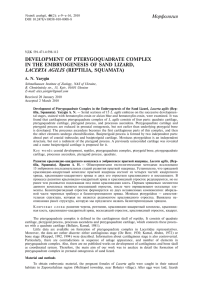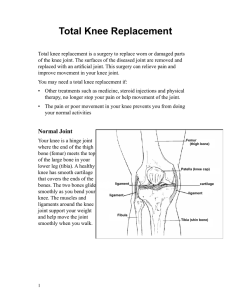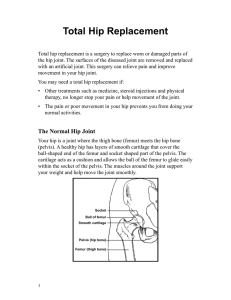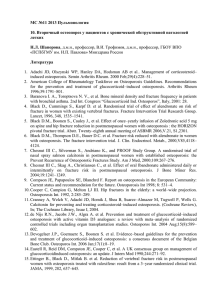DEVELOPMENT OF PTERYGOQUADRATE COMPLEX IN THE EMBRYOGENESIS OF SAND LIZARD, LACERTA AGILIS Ìîðôîëîãèÿ
реклама
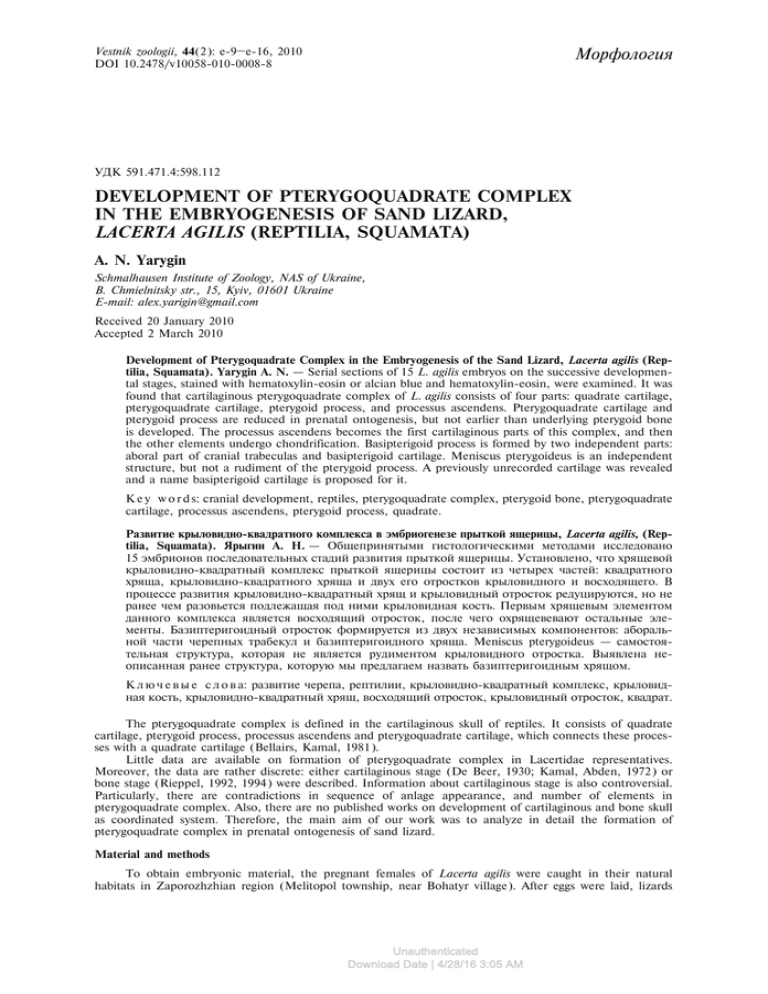
Vestnik zoologii, 44(2): e-9–e-16, 2010 DOI 10.2478/v10058-010-0008-8 Ìîðôîëîãèÿ ÓÄÊ 591.471.4:598.112 DEVELOPMENT OF PTERYGOQUADRATE COMPLEX IN THE EMBRYOGENESIS OF SAND LIZARD, LACERTA AGILIS (REPTILIA, SQUAMATA) A. N. Yarygin Schmalhausen Institute of Zoology, NAS of Ukraine, B. Chmielnitsky str., 15, Kyiv, 01601 Ukraine E-mail: [email protected] Received 20 January 2010 Accepted 2 March 2010 Development of Pterygoquadrate Complex in the Embryogenesis of the Sand Lizard, Lacerta agilis (Reptilia, Squamata). Yarygin A. N. — Serial sections of 15 L. agilis embryos on the successive developmental stages, stained with hematoxylin-eosin or alcian blue and hematoxylin-eosin, were examined. It was found that cartilaginous pterygoquadrate complex of L. agilis consists of four parts: quadrate cartilage, pterygoquadrate cartilage, pterygoid process, and processus ascendens. Pterygoquadrate cartilage and pterygoid process are reduced in prenatal ontogenesis, but not earlier than underlying pterygoid bone is developed. The processus ascendens becomes the first cartilaginous parts of this complex, and then the other elements undergo chondrification. Basipterigoid process is formed by two independent parts: aboral part of cranial trabeculas and basipterigoid cartilage. Meniscus pterygoideus is an independent structure, but not a rudiment of the pterygoid process. A previously unrecorded cartilage was revealed and a name basipterigoid cartilage is proposed for it. K e y w o r d s: cranial development, reptiles, pterygoquadrate complex, pterygoid bone, pterygoquadrate cartilage, processus ascendens, pterygoid process, quadrate. Ðàçâèòèå êðûëîâèäíî-êâàäðàòíîãî êîìïëåêñà â ýìáðèîãåíåçå ïðûòêîé ÿùåðèöû, Lacerta agilis, (Reptilia, Squamata). ßðûãèí À. Í. — Îáùåïðèíÿòûìè ãèñòîëîãè÷åñêèìè ìåòîäàìè èññëåäîâàíî 15 ýìáðèîíîâ ïîñëåäîâàòåëüíûõ ñòàäèé ðàçâèòèÿ ïðûòêîé ÿùåðèöû. Óñòàíîâëåíî, ÷òî õðÿùåâîé êðûëîâèäíî-êâàäðàòíûé êîìïëåêñ ïðûòêîé ÿùåðèöû ñîñòîèò èç ÷åòûðåõ ÷àñòåé: êâàäðàòíîãî õðÿùà, êðûëîâèäíî-êâàäðàòíîãî õðÿùà è äâóõ åãî îòðîñòêîâ êðûëîâèäíîãî è âîñõîäÿùåãî.  ïðîöåññå ðàçâèòèÿ êðûëîâèäíî-êâàäðàòíûé õðÿù è êðûëîâèäíûé îòðîñòîê ðåäóöèðóþòñÿ, íî íå ðàíåå ÷åì ðàçîâüåòñÿ ïîäëåæàùàÿ ïîä íèìè êðûëîâèäíàÿ êîñòü. Ïåðâûì õðÿùåâûì ýëåìåíòîì äàííîãî êîìïëåêñà ÿâëÿåòñÿ âîñõîäÿùèé îòðîñòîê, ïîñëå ÷åãî îõðÿùåâåâàþò îñòàëüíûå ýëåìåíòû. Áàçèïòåðèãîèäíûé îòðîñòîê ôîðìèðóåòñÿ èç äâóõ íåçàâèñèìûõ êîìïîíåíòîâ: àáîðàëüíîé ÷àñòè ÷åðåïíûõ òðàáåêóë è áàçèïòåðèãîèäíîãî õðÿùà. Meniscus pterygoideus — ñàìîñòîÿòåëüíàÿ ñòðóêòóðà, êîòîðàÿ íå ÿâëÿåòñÿ ðóäèìåíòîì êðûëîâèäíîãî îòðîñòêà. Âûÿâëåíà íåîïèñàííàÿ ðàíåå ñòðóêòóðà, êîòîðóþ ìû ïðåäëàãàåì íàçâàòü áàçèïòåðèãîèäíûì õðÿùîì. Ê ë þ ÷ å â û å ñ ë î â à: ðàçâèòèå ÷åðåïà, ðåïòèëèè, êðûëîâèäíî-êâàäðàòíûé êîìïëåêñ, êðûëîâèäíàÿ êîñòü, êðûëîâèäíî-êâàäðàòíûé õðÿù, âîñõîäÿùèé îòðîñòîê, êðûëîâèäíûé îòðîñòîê, êâàäðàò. The pterygoquadrate complex is defined in the cartilaginous skull of reptiles. It consists of quadrate cartilage, pterygoid process, processus ascendens and pterygoquadrate cartilage, which connects these processes with a quadrate cartilage (Bellairs, Kamal, 1981). Little data are available on formation of pterygoquadrate complex in Lacertidae representatives. Moreover, the data are rather discrete: either cartilaginous stage (De Beer, 1930; Kamal, Abden, 1972) or bone stage (Rieppel, 1992, 1994) were described. Information about cartilaginous stage is also controversial. Particularly, there are contradictions in sequence of anlage appearance, and number of elements in pterygoquadrate complex. Also, there are no published works on development of cartilaginous and bone skull as coordinated system. Therefore, the main aim of our work was to analyze in detail the formation of pterygoquadrate complex in prenatal ontogenesis of sand lizard. Material and methods To obtain embryonic material, the pregnant females of Lacerta agilis were caught in their natural habitats in Zaporozhzhian region (Melitopol township, near Bohatyr village). After eggs were laid, lizards Unauthenticated Download Date | 4/28/16 3:05 AM e-10 A. N. Yarygin were set free into their natural habitats. Eggs were incubated on moist substrate at 19–21°Ñ. Then eggs were incubated for approximately 70 days. In total, 15 L. agilis embryos on the successive developmental stages were studied. Special attention was paid to developmental stages with mainly qualitative changes (stages 32–36). The stages were determined according to the tables of normal development for Zootoca vivipara by J. Dufaure and J. Hubert (1961). Embryos were fixed in 3% formaldehyde solution and serial sections (5–7 µm and 10–12 µm) were prepared. Sections were stained with hematoxylin-eosin or alcian blue — hematoxylin-eosin. In this work, we use the terminology of G.R. De Beer (De Beer, 1930) and A.M. Bellairs and A.M. Kamal (Bellairs, Kamal, 1981). Images of microsections were made using microscope Zeiss Axio Imager M1 and Zeiss Axio Vision v.4.63 software in the center of unique equipment at Schmalhausen Institute of zoology, NAS of Ukraine. Results At the beginning of stage 32, it was possible to reveal dense mesenchymal accumulation in head. The parts of future cartilaginous pterygoquadrate complex were clearly distinguished in general loose mass of mesenchymal cells. Stage 32+ Anterolateraly from a cochlear part of the future auditory capsule, there is a dense accumulation of mesenchymal cells — that is the anlage of quadrate cartilage. Vena capitis is located dorso-medialy from auditory process. Oral cavity is observed medially from anlage of qudrate cartilage. Future masticatory musculature is observed as the aggregation of myoblasts, located dorsally to the anlage and dorsolaterally to its anterior part. Ventral surface of anterior part of quadrate cartilage anlage borders with dorsal surface of Meckel’s cartilage posterior part. The anlage of pterygoquadrate cartilage goes aside dorsomedialy from anterior part of dorso-medial margin of quadrate cartilage anlage, looking as a dense band of mesenchymal cells. In front of trifacial neuroganglion (pair V) pterygoquadrate cartilage gives rise to 2 processes — ascending and pterygoid. Pterygoid process, that is mesenchymal one, goes anteriad and rather laterally, and reaches the level of crista sellaris. Aforementioned vena capitis is located dorsally to the process. Oral cavity is located medialy and ventraly to the process. Internal carotid artery and trabeculae are observed ventromedialy to the pterygoid process. Processus ascendens undergoes chondryfication. It goes backwards dorsolateraly and rounds the mandibular branch of trifacial nerve. Vena capitis is located dorsomedially to the process (fig. 1, coloured inset I, p. e-17). To the end of stage 32, all parts of the complex are chondrified. The auditory process of quadrate cartilage grows backwards to the auditory capsule. The pterygoid process grows onward and almost reaches chiasm. Its anterior part bents in lateral direction, approximately at the level of the front edge of hypophysial fenestra. Stage 33 Along the lateral surface of the whole body of pterygoid process and the anterior part of pterygoquadrate cartilage, a new structure appears, that is a dense strand of poorly differentiated cells. The lateral surface of its posterior part practically adjoins to the medial surface of posterior part of pterygoid process. And its anterior part lies rather distantly from the anterior part of pterygoid process. Apex of the strand goes behind the anterior end of pterygoid process and reaches the level of chiasm. Strand cells density decreases from its posterior to anterior end (fig. 2). Stage 33+ Described in the previous stage, cells of the strand form an osteoid, which is rather dorso-ventraly flattened. Its thickness is approximately equal to that of pterygoid process. Thus, formation of the pterygoid bone begins (fig. 3). Unauthenticated Download Date | 4/28/16 3:05 AM Development of pterygoquadrate complex in the embryogenesis … e-11 Fig. 2. Cross-section of Lacerta agilis embryos head Stage 33. ica — internal carotid artery, Mc — Meckel’s cartilage, ppt — processus pterygoideum, rpt — rudiment of pterygoid bone, st — stomodeum, t — trabecula, vc — vena capitis Ðèc. 2. Ïîïåðå÷íûé ñðåç ãîëîâû Lacerta agilis. Ñòàäèÿ 33. ica — âíóòðåííÿÿ ñîííàÿ àðòåðèÿ, Mc — ìåêêåëåâ õðÿù, ppt — êðûëîâèäíûé îòðîñòîê, rpt — çàêëàäêà êðûëîâèäíîé êîñòè, st — stomodeum, t — ÷åðåïíàÿ òðàáåêóëà, vc — vena capitis. Stage 33++ At this stage, mineralization of the osteoid process begins. Osteoid grows onward, its posterior part lies closely to the pterygoid process. Middle and anterior parts are still rather apart from the latter. Due to the lateral bend of pterygoid process, distance between it and a bone increases onward. Pterygoid bone is approximately 1.5 times longer than pterygoid process. Width of the back third of developing bone is equal to Fig. 3. Parasagittal section of Lacerta agilis embryos head. Stage 33+. ppt — processus pterygoideum, rpt — rudiment of pterygoid bone, st — stomodeum, vc — vena capitis. Ðèñ. 3. Ïàðàñàãèòàëüíûé ñðåç ãîëîâû Lacerta agilis. Ñòàäèÿ 33+. ppt — êðûëîâèäíûé îòðîñòîê, rpt — çàêëàäêà êðûëîâèäíîé êîñòè, st — stomodeum, vc — vena capitis. Unauthenticated Download Date | 4/28/16 3:05 AM e-12 A. N. Yarygin the width of pterygoid process, front two thirds of the bone are approximately 2 times wider than the process (fig. 4). Stage 34 Pterygoid bone continues its growth. It grows backwards along pterygoquadrate cartilage, its posterior end does not reach the quadrate cartilage a little. Anterior end goes over the level of chiasm (fig. 5). Ventromedial surfaces of pterygoid process and pterygoquadrate cartilage lie in a groove formed by underlying pterygoid bone. Fig. 4. Frontal section of Lacerta agilis embryos head. Stage 33++. ppt — processus pterygoideum, pt — pterygoid bone. Ðèñ. 4. Ôðîíòàëüíûé ñðåç ãîëîâû Lacerta agilis. Ñòàäèÿ 33++. ppt — êðûëîâèäíûé îòðîñòîê, pt — êðûëîâèäíàÿ êîñòü. Fig. 5. Cross-section of Lacerta agilis embryos head. Stage 34. ica — internal carotid artery, ch-optic chiasm, pt — pterygoid bone, st — stomodeum, tc — trabecula communis. Ðèñ. 5. Ïîïåðå÷íûé ñðåç ãîëîâû Lacerta agilis. Ñòàäèÿ 34. ica — âíóòðåííÿÿ ñîííàÿ àðòåðèÿ, ch — õèàçìà çðèòåëüíûõ íåðâîâ, pt — êðûëîâèäíàÿ êîñòü, st — stomodeum, tc — òðàáåêóëÿðíàÿ ïëàñòèíêà. Unauthenticated Download Date | 4/28/16 3:05 AM Development of pterygoquadrate complex in the embryogenesis … e-13 Processus ascendens and pterygoid processes have the same base, which also lies in this bone groove. Basitrabecular (basipterigoid) process goes ventrolaterally and onward from posterior part of trabeculas. Its end is directed to the base of processus ascendens. Cartilaginous meniscus pterigoideus is revealed near the dorso-medial surface of the base of processus ascendens. The dense mesenchymal “bridge” is observed between Fig. 7. Cross-section of Lacerta agilis embryos head. Stage 34+. bptc — basipterigoid cartilage, btrp — basitrabecular process, mpt — pterigoid meniscus, pasc — processus ascendens, pt — pterygoid bone. Ðèñ. 7. Ïîïåðå÷íûé ñðåç ãîëîâû Lacerta agilis. Ñòàäèÿ 34+. bptc — áàçèïòåðèãîèäíûé õðÿù, btrp — áàçèòðàáåêóëÿðíûé îòðîñòîê, mpt — ïòåðèãîèäíûé ìåíèñê, pasc — âîñõîäÿùèé îòðîñòîê, pt — êðûëîâèäíàÿ. Fig. 8. Cross-section of Lacerta agilis embryos head. Stage 34 ++. Mc — Meckel’s cartilage pt — pterygoid bone, ptqc — pterygoquadrate cartilage. Ðèñ. 8. Ïîïåðå÷íûé ñðåç ãîëîâû Lacerta agilis. Ñòàäèÿ 34 ++. Mc — ìåêêåëåâ õðÿù, pt — êðûëîâèäíàÿ êîñòü, ptqc — êðûëîâèäíî-êâàäðàòíûé õðÿù. Unauthenticated Download Date | 4/28/16 3:05 AM e-14 A. N. Yarygin basitrabecular process and pterigoid meniscus. In this mesenchymal mass, it is possible to distinguish separate locus of chondrification, designated as “basipterigoid cartilage” (fig. 6). S t a g e o f 3 4 + (coloured inset, p. e-17) The main changes occur only in junction between an axial part of the skull and the pterygoquadrate complex. Mesenchymal “bridge”, described for the previous stage, is completely cartilaginous and fused with basitrabecular process. However, the border of this fusion is still well distinguished (fig. 7). Fig. 9. Cross-section of Lacerta agilis embryos head. Stage 34 ++. bptc — basipterigoid cartilage, btrp — basitrabecular process, mpt — pterigoid meniscus, pasc — processus ascendens, pt — pterygoid bone, vc — vena capitis. Ðèñ. 9. Ïîïåðå÷íûé ñðåç ãîëîâû Lacerta agilis. Ñòàäèÿ 34 ++. bptc — áàçèïòåðèãîèäíûé õðÿù, btrp — áàçèòðàáåêóëÿðíûé îòðîñòîê, mpt — ïòåðèãîèäíûé ìåíèñê, pasc — âîñõîäÿùèé îòðîñòîê, pt — êðûëîâèäíàÿ êîñòü, vc — vena capitis. Fig. 10. Cross-sections of Lacerta agilis embryos head arranged in an anterior to posterior sequence (a, b). Stage 35. ppt — processus pterygoideum, pt — pterygoid bone, ptqc — pterygoquadrate cartilage. Ðèñ. 10. Ïîïåðå÷íûå ñðåçû ãîëîâû Lacerta agilis (a, b). Ñòàäèÿ 35. ppt — êðûëîâèäíûé îòðîñòîê, pt — êðûëîâèäíàÿ êîñòü, ptqc — êðûëîâèäíî-êâàäðàòíûé õðÿù. Unauthenticated Download Date | 4/28/16 3:05 AM Development of pterygoquadrate complex in the embryogenesis … e-15 Fig. 11. Areas of hypertrophied cartilage (framed) in processus ascendens (a) and quadrate cartilage (b). Cross-sections of Lacerta agilis embryos head. Stage 35. Ðèñ. 11. Çîíà ãèïåðòðîôèðîâàííîãî õðÿùà (âûäåëåíî ïðÿìîóãîëüíèêîì) â âîñõîäÿùåì îòðîñòêå (a) è êâàäðàòíîì õðÿùå (b). Ïîïåðå÷íûå ñðåçû ãîëîâû Lacerta agilis. Ñòàäèÿ 35. Stage 34 ++ The posterior end of pterygoid bone reaches the quadrate cartilage. Pterygoquadrate cartilage is thinned, its posterior end looses contact with quadrate cartilage (fig. 8). It is clearly visible that basitrabecular process consists of two cartilages (fig. 9). Stage 35 Pterygoquadrate cartilage and pterygoid process are extremely thinned (fig. 10). The cells of processus ascendens and quadrate cartilage are hypertrophied (fig. 11). Stage 36+ To investigate onset of ossification on a whole structure, the whole mounts of the embryos were studied at this stage. Bone cuffs are clearly visible in the middle part of processus ascendens and the middle part of quadrate cartilage. They topographically correspond to hypertrophied cartilage areas observed at the previous stage (fig. 12, coloured inset II, p. e-18). Discussion According to G. De Beer’s data, quadrate cartilage is the first cartilaginous part of pterygoquadrate complex in cranial embryogenesis of L. agilis. Then processus ascendens develops, being not connected with any other cartilaginous structure. At the final stage of chondrogenesis, G. De Beer found an independent small cartilage — meniscus pterygoideus between basitrabecular process and basis of processus ascendens. The author did not find pterygoid process and pterygoquadrate cartilage at any stages examined. Ernst Gaup noted the presence of “dense tissue” between quadrate cartilage and processus ascendens, which later undergoes chondrification (pterygoquadrate cartilage) (Gaup, 1891, cyted by De Beer, 1930). From these facts, G. De Beer (1930) suggested, that quadrate cartilage was not obviously represented as separate structure in embryogenesis of L. agilis. According to A. M. Kamal and A. M. Abden’s data on another representative of Lacertidae family (Acanthodactylus boskiana), all four parts of pterygoquadrate complex are formed simultaneously as a single cartilaginous structure. However, in evolvement, Unauthenticated Download Date | 4/28/16 3:05 AM e-16 A. N. Yarygin pterygoquadrate cartilage and pterygoid processes are exposed to “ontogenetic regression” (Kamal, Abden, 1972: 313). When formation of chondrocranium is completed, pterygoquadrate cartilage disappears, and pterygoquadrate complex consists of three separate elements: quadrate cartilage, processus ascendens and preserved back part of pterygoid process — meniscus pterygoideus (Kamal, Abden, 1972). Our research showed that the pterygoquadrate complex of sand lizard was formed within a single mesenchymal mass. However, the first cartilaginous part of the complex is processus ascendens, which undergoes chondrification in the beginning of the 32+nd stage. We did not succeed to find individual foci of chondrification in other parts of the complex. To the end of this stage, all parts of pterygoquadrate complex were fused into a single cartilaginous structure. At the beginning of stage 34, we found meniscus pterygoideus in the base of processus ascendens, what corresponds to G. R. De Beer’s data. Here we also revealed an individual cartilage (designated as basipterigoid cartilage) located between meniscus pterygoideus and basipterigoid process, which fused with basipterigoid process later in evolvement. This cartilage was never been described earlier. Detailed study of serial sections provided the evidence that meniscus pterygoideus is an individual structure rather than a preserved part of pterygoid process, as it was considered earlier (Kamal, Abden, 1972). The pterygoid process and pterygoquadrate cartilage are really reduced what confirmed A. M. Kamal and A. M. Abden’s data (1972). However, “ontogenetic regression” of cartilages began not earlier than the posterior end of the underlying pterygoid bone reached a quadrate cartilage, and the first lost connection was between quadrate and pterygoquadrate cartilages. Our results about sequence of pterygoquadrate complex ossification events coincide with O. Rieppel’s data (Rieppel, 1992, 1993). Conclusion It was defined that cartilaginous pterygoquadrate complex of L. agilis consists of four parts: quadrate cartilage, pterygoquadrate cartilage, pterygoid process and processus ascendens. Pterygoquadrate cartilage and pterygoid process are reduced in prenatal ontogenesis, but not earlier than underlying pterygoid bone develops. The processus ascendens becomes the first cartilaginous part of this complex, and then other parts undergo chondrification. Basipterigoid process is formed by two independent components: aboral part of cranial trabeculas and basipterigoid cartilage. Meniscus pterygoideus is an independent structure, and it is not the rudiment of pterygoid process. Bellairs A d’A, Kamal A. M. The chondrocranium and the development of the skull in recent reptiles // Biology of the Reptilia. vol. 11. Morphology F / C. Gans, TS. Parsons. — London : Academic Press, 1981. — P. 1–263. de Beer G. R. The Early Development of the Chondrocranium of the Lizard // Quarterly J. of Microscopical Science. — 1930. — 2–73, N 292. — P. 707–739. Dufaure J, Hubert J. Table de developpement du lizard vivipare: Lacerta (Zootoca) vivipara Jacquin // Arch. Anat. Microsc. Morphol. Exp. — 1961. — 50, N 2. — P. 309–328. Kamal A. M., Abdeen A. M. The development of the chondrocranium of the lacertid lizard, Acanthodactylus boskiana // J. Morph. — 1972. — 137, N 3. — P. 289–334. Rieppel O. Studies on Skeleton Formation in Reptiles III. Patterns of Ossification in the Skeleton of Lacerta vivipara Jacquin (Reptilia, Squamata) // Fieldiana NS. — 1992. — N 68. — P. 1–25. Rieppel O. Studies on Skeleton Formation in Reptiles. Patterns of Ossification in the Skeleton of Lacerta agilis exigua Eichwald (Reptilia, Squamata) // J. of Herpetology. — 1994. — 28, N 2. — P. 145–153. Unauthenticated Download Date | 4/28/16 3:05 AM Development of pterygoquadrate complex in the embryogenesis … e-17 Inset to the paper by A. N. Yarygin (p. 108). Fig. 1. Ñross-sections of Lacerta agilis embryos head arranged in an anterior to posterior sequence (a, b). Stage 32+. ica — internal carotid artery, Mc — Meckel’s cartilage, pa — pila antotica, pasc — processus ascendens, rppt — rudiment of processus pterygoideum, rpqc — mesenchymal rudiment of pterygoquadrate cartilage, rq — mesenchymal rudiment of quadrate cartilage, st — stomodeum, t — trabecula, vc — vena capitis. Ê ñòàòüå À. Í. ßðûãèíà (ñ. 108). Ðèñ. 1. Ïîïåðå÷íûå ñðåçû ãîëîâû Lacerta agilis (a, b). Ñòàäèÿ 32+. ica — âíóòðåííÿÿ ñîííàÿ àðòåðèÿ, Mc — ìåêêåëåâ õðÿù, pa — pila antotica, pasc — âîñõîäÿùèé îòðîñòîê, rppt — ìåçåíõèìíàÿ çàêëàäêà êðûëîâèäíîãî îòðîñòêà, rpqc — ìåçåíõèìíàÿ çàêëàäêà êðûëîâèäíî-êâàäðàòíîãî õðÿùà, rq — ìåçåíõèìíàÿ çàêëàäêà êâàäðàòíîãî õðÿùà, st — stomodeum, t — ÷åðåïíàÿ òðàáåêóëà, vc — vena capitis. Inset to the paper by A. N. Yarygin (ð. 112). Fig. 6. Cross-section of Lacerta agilis embryos head. Stage 34. bptc — basipterigoid cartilage, btrp — basitrabecular process, ica — internal carotid artery, Mc — Meckel’s cartilage, mpt — pterigoid meniscus, pasc — processus ascendens, pt — pterygoid bone, st — stomodeum, t — trabecula, vc — vena capitis. Ê ñòàòüå À. Í. ßðûãèíà (ñ. 112). Ðèñ. 6. Ïîïåðå÷íûé ñðåç ãîëîâû Lacerta agilis. Ñòàäèÿ 34. bptc — áàçèïòåðèãîèäíûé õðÿù, btrp — áàçèòðàáåêóëÿðíûé îòðîñòîê, ica — âíóòðåííÿÿ ñîííàÿ àðòåðèÿ, Mc — ìåêêåëåâ õðÿù, mpt — ïòåðèãîèäíûé ìåíèñê, pasc — âîñõîäÿùèé îòðîñòîê, pt — êðûëîâèäíàÿ êîñòü, st — stomodeum, t — ÷åðåïíàÿ òðàáåêóëà, vc — vena capitis. Unauthenticated Download Date | 4/28/16 3:05 AM e-18 A. N. Yarygin Inset to the paper by A. N. Yarygin (ð. 113). Fig. 12. Head of Lacerta agilis embryo at stage 36+. Lateral view. ac — auditory capsule, Mc — Meckel's cartilage, p — parietal bone, pasc — processus ascendens, pt — pterygoid bone, sq — squamosal bone, q — quadrate. Ê ñòàòüå À. Í. ßðûãèíà (ñ. 113). Ðèñ. 12. Ãîëîâà ýìáðèîíà Lacerta agilis íà ñòàäèè 36+. Âèä ñáîêó. ac — ñëóõîâàÿ êàïñóëà, Mc — ìåêêåëåâ õðÿù, p — òåìåííàÿ êîñòü, pasc — âîñõîäÿùèé îòðîñòîê, pt — êðûëîâèäíàÿ êîñòü, sq — ÷åøóé÷àòàÿ êîñòü, q — êâàäðàò. Unauthenticated Download Date | 4/28/16 3:05 AM
